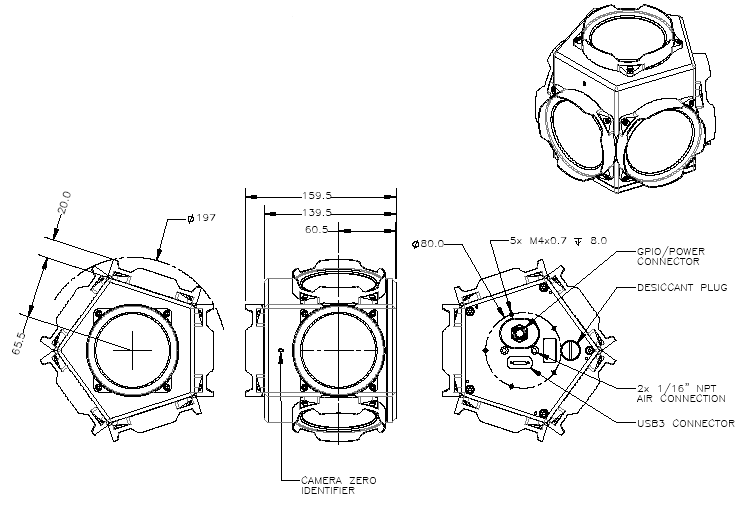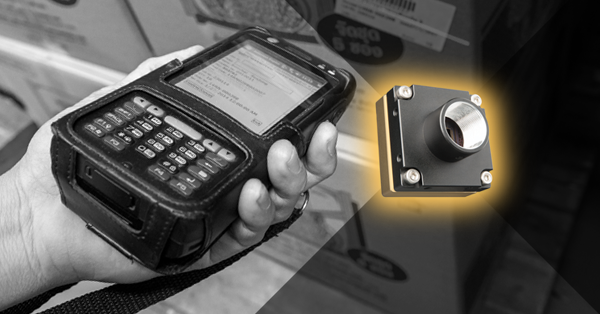Transitioning from Ladybug3 to Ladybug5
Download PDF - Transitioning_LD3_to_LD5
Questions about Upgrading from Ladybug3 to Ladybug5
Is Ladybug3 being discontinued?
No, there are no plans to discontinue Ladybug3 at this time. The new Ladybug5 provides the advantages of USB 3.1 and next-generation functionality.
What other hardware is needed to use Ladybug5?
Interface Card—The Ladybug5 requires a USB 3.1 PCIe host controller card compliant with the SuperSpeed USB Specification and the xHCI Specification. A host controller card is provided with the camera.
Cable—The Ladybug5 requires a USB 3.1 Type-A to Micro-B cable with locking screws. A 5 m cable is provided with the camera.
Power supply—Power must be provided through the 12-pin GPIO interface. The required input voltage is 12-24 V. A power supply and wiring harness is provided with the camera.
Mounting—Both a desktop and a tripod mount are provided with the camera.
Can I run Ladybug5 with my existing application?
The Ladybug SDK version 1.7 is required to run Ladybug5. This version of the SDK contains the following new features and enhancements:
- Added support for USB3 drivers
- Added ladybugGetGrabTimeout() call to API
- Added PNG quick save option to toolbar in LadybugCapPro
- Added support for Auto Shutter Range control
- Added support for three Auto Exposure preset modes
- Added keyboard shortcuts for zoom/pan functionality in LadybugCapPro
- Added memory channel save/restore to API
- Added environmental sensor support for Ladybug5
- User interface modifications to new features
|
|
Using an earlier version of the Ladybug SDK with Ladybug5 is not supported. |
Additionally, the Ladybug SDK contains several new example programs to support new the features of Ladybug5, including:
- ladybugEnvironmentalSensors
- ladybugPostProcessing
- ladybugTranslate2dTo3d
How easy is it to migrate from FireWire to USB 3.1?
The Ladybug3 is a FireWire (IIDC-1394) camera while the Ladybug5 is a USB 3.1 camera. However, the IIDC-based control and status registers in the camera firmware, which are accessed by Point Grey’s Ladybug API, remain mostly the same between the cameras. As a result, upgrading an application from the Ladybug3 FireWire to the Ladybug5 USB 3.1 should be fairly straightforward.
Among the factors to consider are supported pixels formats and modes. The Ladybug5 offers a raw image format that has no on-camera image processing; all image processing is performed on the PC. This allows users to fine tune their output settings as a separate step after image acquisition.
How does the performance compare?
Data throughput on the IIDC-1394b bus is 800 Mb/s while on the USB 3.1 network it is 5 Gbit/s.
Ladybug5 Image Processing Pipeline
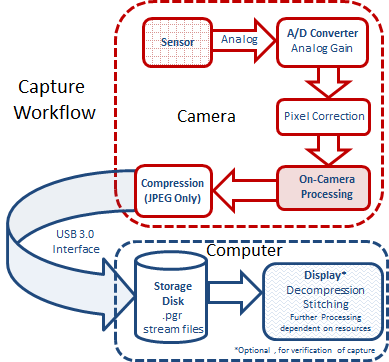
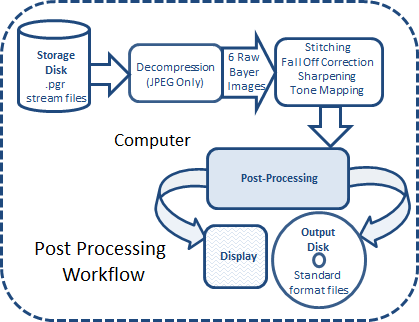
Image Processing
For both Ladybug3 and Ladybug5, when using Raw8 or JPEG8 pixel formats, some image processing is done on the camera during capture before being output to the PC. Additional post processing is then performed on the PC.
For Ladybug5 when using Raw12, RAW16, or JPEG12 pixel formats, most of the image processing is done on the PC. This processing is done as part of ladybugConvertImage(). This allows users to fine tune the output settings independently from image capture.
User access to adjusting the parameters for image processing is available in LadybugCapPro or via CSRs.
|
Description |
Ladybug3 |
Ladybug5 |
|
|
8-bit Pixel Formats |
On-Camera Processing |
|
|
|
Post Processing on PC |
|
|
|
|
12- or 16-bit Pixel Formats |
On-Camera Processing |
Not Supported |
|
|
Post Processing on PC |
Not Supported |
|
|
Data Format
|
Description |
Ladybug3 |
Ladybug5 |
|
Image Data Formats |
Raw8, Mono8, JPEG8 |
Raw8, Raw12, Raw16, JPEG8, JPEG12 |
|
Video Data Output |
8-bit Raw Bayer digital data |
8-, 12-, or 16-bit Raw or JPEG compressed |
|
Resolution Full |
1616 x 1232 |
2448 x 2048 |
|
Resolution Half |
1616 x 616 |
2448 x 1024 |
Formats, Frame Rates, Image Sizes
|
Pixel Format |
Ladybug3 |
Ladybug5 |
||||||
|
Frame Rate |
Image Size |
Frame Rate |
Image Size |
|||||
|
Full |
Half |
Full |
Half |
Full |
Half |
Full |
Half |
|
|
Raw8 |
6.5 |
13 |
12 MB |
6 MB |
8 |
16 |
30 MB |
15 MB |
|
JPEG8 Comp |
16 |
32 |
Variable |
Variable |
10 |
16 |
Variable |
Variable |
|
Raw12 |
N/A |
N/A |
N/A |
N/A |
5 |
10.5 |
45 MB |
22.5 MB |
|
JPEG12 Comp |
N/A |
N/A |
N/A |
N/A |
10 |
16 |
Variable |
Variable |
|
Raw16 |
N/A |
N/A |
N/A |
N/A |
4 |
8 |
60 MB |
30 MB |
Shutter Range
Both Ladybug3 and Ladybug5 offer three preset shutter range modes to set the maximum shutter value:
- Motion—maximum shutter is set to as short as possible to prevent motion blur. Best used outdoors or images may be too dark. This is the default.
- Indoor—maximum shutter is slightly longer than the motion mode, for use in indoor applications.
- Low Noise—maximum shutter is not restricted.
Auto Exposure Modes
Ladybug5 offers three preset modes for the auto exposure algorithm:
- Bottom 50%—uses only the bottom 50% of the five side cameras and excludes the top camera from its calculations.
- Top 50%—uses only top 50% of the five side cameras and includes the top camera in its calculations. This is the upside down version of the first mode, used when the camera is mounted upside down (for example, on a helicopter).
- Full Image—uses the entire image of all six cameras for its calculations. This is the default.
For 8-bit pixel formats, the auto exposure modes are set for image capture. For 12- and 16-bit pixel formats, the auto exposure modes are set both for image capture and post processing on the PC.
Software Workflow
Image Acquisition
The Ladybug5 can be started and controlled in the same way as Ladybug3.
Stream Recording
The Ladybug5 has a much greater maximum bandwidth and the amount of data written to disk per second is substantially greater than Ladybug3. It is possible to greatly reduce the amount of data sent in JPEG modes by reducing the compression quality.
Image Processing and Stitching
The workflow for data formats with on-camera image processing remains the same. See the LadybugPanoStitch example for an example.
For data formats that do not perform image processing on-camera, see ladybugImageAdjustment.h in the \include directory for image processing parameters as well as usage instructions. In addition, the LadybugCapPro application provides a graphical interface to these parameters.
In both cases, ladybugConvertImage() prepares the image for output purposes, including JPEG decompression, Bayer demosaicing as well as image post processing.
Image Output
The image output functionality remains the same as LadybugCapPro 1.6. If a full resolution panoramic image is desired, it is recommended that an output size of 10000 x 5000 is used.
Image Size
For Ladybug3, the size of a single camera image after image conversion is 1616 x 1232.
For Ladybug5, the size of a single camera image after image conversion is 2448 x 2048.
If your software allocates its own memory for image conversion and texture updating, the amount of memory to be allocated should be 6 x W x H x (bytes per channel), where bytes per channel is 1 for 8-bit modes, 1.5 for 12-bit modes, and 2 for 16-bit modes.
For example, the memory size required to contain a JPEG8 image after conversion is:
Ladybug3 = 6 x 1616 x 1232 x 1 = 11945472 bytes
Ladybug5 = 6 x 2448 x 2048 x 1 = 30081024 bytes
Detailed Comparison between the Ladybug3 and Ladybug5
Mechanical Properties
|
Description |
Ladybug3 |
Ladybug5 |
|
Digital Interface |
9-pin 1394b 800 Mbit/s interface for camera control, power, and video data, with locking screws for secure connection |
USB 3.1 for camera control and video data, with locking screws for secure connection |
|
General Purpose I/O Ports |
8-pin GPIO connector for external trigger, strobe output, serial port, or power |
12-pin GPIO connector for external trigger input, strobe output, and power |
|
IR Filter |
The infrared cut-off filter used has the same transmittance properties |
|
|
Dimensions |
122 mm x 141 mm |
149 mm x 179 mm |
|
Optics |
Six high quality 3.3 mm focal length lenses |
Six high quality 4.4 mm focal length lenses |
|
Case |
Machined aluminum housing, anodized red or black; single unit, water resistant |
|
|
Mass |
2414 g |
~2900 g |
|
Mounting |
The case is equipped with five M4 X 0.7 mounting holes on the bottom that can be used to attach the camera directly to the desktop mount, tripod adapter, or a custom mount |
|
|
Desiccant |
Not available |
Desiccant plug to minimize moisture in the enclosure and prevent lens fogging |
|
Transfer Rates |
800 Mbit/s |
5 Gbit/s |
GPIO Properties
|
Pin |
Ladybug3 |
Ladybug5 |
||
|
Function |
Description |
Function |
Description |
|
|
1 |
I1 |
Opto-isolated Input |
OPTO_GND |
Ground for opto-isolated IO pins |
|
2 |
O1 |
Opto-isolated Output |
I1 |
Opto-isolated Input |
|
3 |
IO2 |
Input/Output/RS232 Transmit (TX) |
O1 |
Opto-isolated Output |
|
4 |
IO3 |
Input/Output/RS232 Receive (RX) |
IO2 |
Input/Output |
|
5 |
GND |
Ground for bi-directional IO, VEXT, +3.3 V |
+3.3 V |
Power external circuitry up to 150 mA |
|
6 |
OPTO_GND |
Ground for opto-isolated IO pins |
GND |
Ground pin for bi-directional IO, VEXT, +3.3 V |
|
7 |
VEXT |
Allows camera to be powered externally |
VEXT |
Allows camera to be powered externally |
|
8 |
+3.3 V |
Power external circuitry up to 150 mA |
VEXT |
Allows camera to be powered externally |
|
9 |
Not applicable |
VEXT |
Allows camera to be powered externally |
|
|
10 |
Not applicable |
OPTO_GND |
Ground for opto-isolated IO pins |
|
|
11 |
Not applicable |
IO3 |
Input/Output |
|
|
12 |
Not applicable |
GND |
Ground for bi-directional IO, VEXT, +3.3 V |
|
Hardware/Electronics
|
Description |
Ladybug3 |
Ladybug5 |
|
Sensors |
Sony ICX274 CCD x 6 |
Sony ICX655 CCD x 6 |
|
Power Interface |
via GPIO or FireWire interface |
via GPIO |
|
Power Consumption |
7.2 W at 12 V |
12-24 V, 13 W |
|
A/D Converter |
12-bit |
|
|
Environmental Sensors |
Temperature |
Temperature, Barometer, Humidity, Accelerometer, Compass |
|
LED |
One general purpose status LED for monitoring camera power, initialization, and FireWire activity |
One general purpose status LED for monitoring camera power, initialization, and USB 3.1 activity |
|
Operating Temperature |
0° to 45°C |
|
|
Storage Temperature |
-30° to 60°C |
|
|
Relative humidity Operating |
20 to 80% (no condensation) |
|
|
Relative humidity Storage |
20 to 95% (no condensation) |
|
|
Field of view |
>80% of full sphere |
~90% of full sphere |
|
Spherical Distance |
Calibrated at 20 m |
Calibrated from 2 m to infinity |
|
Focus Distance |
~200 cm. Objects have an acceptable sharpness from ~60 cm to infinity |
|
Firmware
|
Description |
Ladybug3 |
Ladybug5 |
|
Camera Specifications |
IIDC v1.31 |
IIDC v1.32 |
|
High Dynamic Range |
Cycle 4 gain and exposure presets |
|
|
External Trigger Modes |
Trigger Modes 0, 1, 3, 14, 15 |
|
|
Gain |
0 dB to 24 dB |
0 dB to 18 dB |
|
Gamma |
0.50 to 4.00 |
|
|
Shutter Speed |
0.01 ms to 4.2 seconds |
0.02 ms to 2 seconds |
|
Shutter Type |
Global Shutter |
|
|
Memory Channels |
2 memory channels for custom camera settings |
|
|
Flash Memory |
512 KB |
1 MB |
Software, Driver, and System Support
|
Description |
Ladybug3 |
Ladybug5 |
|
Driver Options |
Point Grey FirePRO driver or |
Point Grey PGRxHCI driver |
|
Bandwidth Management |
Guaranteed bandwidth for all cameras on bus |
USB 3.1 does not automatically manage bandwidth allocation |
|
Camera Enumeration |
Enumeration on the FireWire bus is supported natively by the OS |
Enumeration on the Universal Serial Bus is supported natively by the OS |
|
Ladybug SDK versions |
1.3 Alpha 08+ |
1.7 Release X+ |
|
Recommended Operating Systems |
Windows XP 32- or 64-bit |
Windows 7 64-bit |
|
Software Requirements for Ladybug SDK |
Microsoft Visual Studio 2005 |
|
|
CPU (recommended) |
2 GHz Dual/Quad Core |
3 GHz Dual/Quad Core |
|
RAM (recommended) |
2 GB |
8 GB |
Dimensions
Ladybug3 Dimensional Diagram
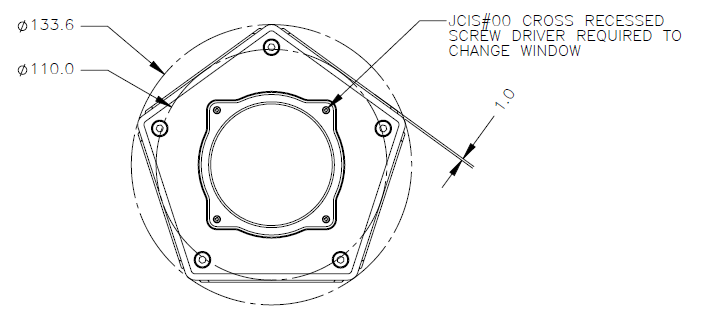
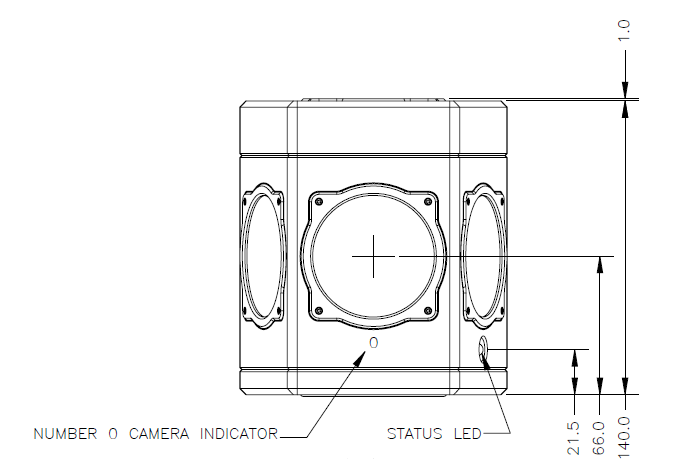
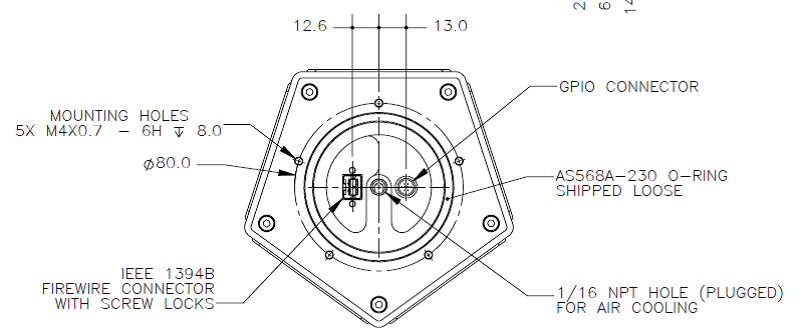
Ladybug5 Dimensional Diagram
